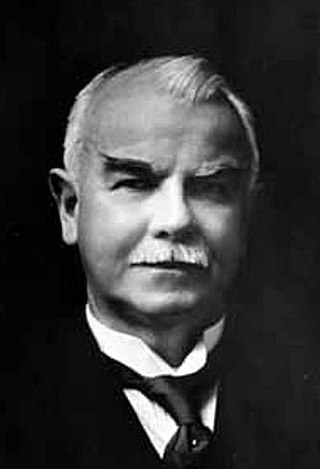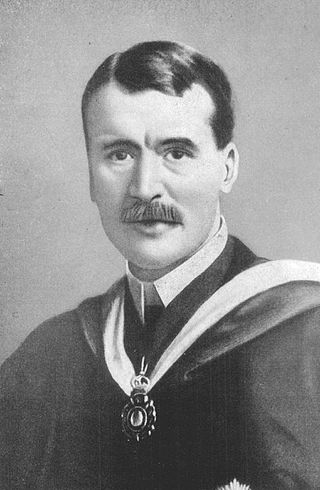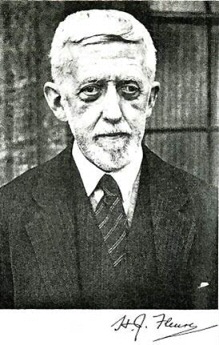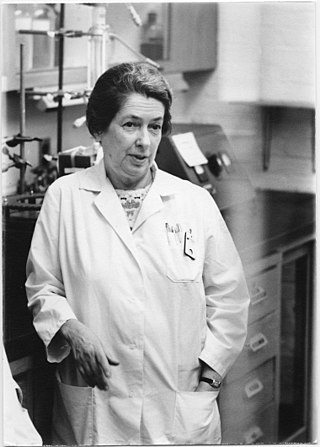Related Research Articles

The Dean Cemetery is a historically important Victorian cemetery north of the Dean Village, west of Edinburgh city centre, in Scotland. It lies between Queensferry Road and the Water of Leith, bounded on its east side by Dean Path and on its west by the Dean Gallery. A 20th-century extension lies detached from the main cemetery to the north of Ravelston Terrace. The main cemetery is accessible through the main gate on its east side, through a "grace and favour" access door from the grounds of Dean Gallery and from Ravelston Terrace. The modern extension is only accessible at the junction of Dean Path and Queensferry Road.

Sir Alfred Charles Bernard Lovell was an English physicist and radio astronomer. He was the first director of Jodrell Bank Observatory, from 1945 to 1980.

Sir James Alfred EwingMInstitCE was a Scottish physicist and engineer, best known for his work on the magnetic properties of metals and, in particular, for his discovery of, and coinage of the word, hysteresis.
The Manchester Literary and Philosophical Society, popularly known as the Lit. & Phil., is one of the oldest learned societies in the United Kingdom and second oldest provincial learned society.
David Tabor , FRS was a British physicist who was an early pioneer of tribology, the study of frictional interaction between surfaces, and well known for his influential undergraduate textbook "Gases, Liquids and Solids".

Sir Thomas Henry Holland was a British geologist who worked in India with the Geological Survey of India, serving as its director from 1903 to 1910. He later worked as an educational administrator at Edinburgh University.

The Michael Faraday Medal and Prize is a gold medal awarded annually by the Institute of Physics in experimental physics. The award is made "for outstanding and sustained contributions to experimental physics." The medal is accompanied by a prize of £1000 and a certificate.
The Victoria Medal is an award presented by the Royal Geographical Society. It is awarded "for conspicuous merit in research in geography" and has been given since 1902, in honour of the late Queen Victoria. Up until then, the society's Patron's Medal had alternatively been known as the "Victoria Medal", and the new medal resembled its original design.
The Kelvin Gold Medal is a British engineering prize.

The Department of Physics and Astronomy at the University of Manchester is one of the largest and most active physics departments in the UK, taking around 250 new undergraduates and 50 postgraduates each year, and employing more than 80 members of academic staff and over 100 research fellows and associates. The department is based on two sites: the Schuster Laboratory on Brunswick Street and the Jodrell Bank Centre for Astrophysics in Cheshire, international headquarters of the Square Kilometre Array (SKA).
The Dennis Gabor Medal and Prize is a prize awarded biannually by the Institute of Physics for distinguished contributions to the application of physics in an industrial, commercial or business context. The medal is made of silver and is accompanied by a prize and a certificate.

Herbert John Fleure, was a British zoologist and geographer. He was secretary of the Geographical Association, editor of Geography, and president of the Cambrian Archaeological Association (1924–25), Royal Anthropological Institute (1945–47) and Geographical Association (1948–49).

Sir Charles Edward Inglis, was a British civil engineer. The son of a doctor, he was educated at Cheltenham College and won a scholarship to King's College, Cambridge, where he would later forge a career as an academic. Inglis spent a two-year period with the engineering firm run by John Wolfe-Barry before he returned to King's College as a lecturer. Working with Professors James Alfred Ewing and Bertram Hopkinson, he made several important studies into the effects of vibration on structures and defects on the strength of plate steel.
The Southern Africa Association for the Advancement of Science (S2A3 or S2A3) is a learned society, originally known as the South African Association for the Advancement of Science (SAAAS). Established in 1902, its principal aim is to increase the public awareness and understanding of science, engineering and technology, and their role in society, by means of various awards and by communicating the nature, processes, ethics, and excitement of science. Membership is open to all.

Gertrude Erika Perlmann was an Austro-Hungarian Empire-born U.S. biochemist and structural biologist. She is known for her work in protein chemistry, particularly her discoveries on the biology phosphoproteins and the structure and action of pepsin and pepsinogen.

The Valz Prize(Prix Valz) was awarded by the French Academy of Sciences, from 1877 through 1970, to honor advances in astronomy.
George McCreath Wyburn FRSE FRFPSG (1903–1985) was a British embryologist. He served as Professor of Anatomy at Glasgow University from 1948 to 1972.
References
- ↑ "Presentation of James Alfred Ewing Medal", Nature, 141 (3575): 825, 7 May 1938, Bibcode:1938Natur.141U.825., doi: 10.1038/141825e0 , S2CID 43551505
- ↑ Journal of the Institution of Civil Engineers, Volumes 19-20
- ↑ "James Alfred Ewing Medal: Award to Mr. B. N. Wallis", Nature, 155 (3946): 721, 16 June 1945, Bibcode:1945Natur.155R.721., doi: 10.1038/155721b0 , S2CID 4122889
- ↑ "Institution of Civil Engineers: James Alfred Ewing Medal", Nature, 161 (4094): 592, 17 April 1948, Bibcode:1948Natur.161R.592., doi: 10.1038/161592b0 , S2CID 7445648
- ↑ The International Who's Who 2004
- ↑ "Institutions unite to honour outstanding engineers". 13 November 2003.
- ↑ "Tony-unsworth".
- ↑ "Department News". Archived from the original on 2014-05-27. Retrieved 2015-12-04.